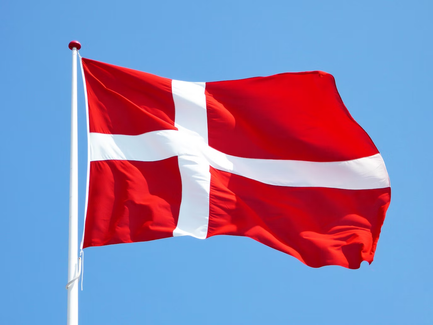For admission to a Finnish university, you need to provide a certificate of language proficiency in either Finnish, Swedish, or English. Some universities of applied sciences may also require bachelor’s entrance examinations, as well as confirmation of at least two years of relevant experience for master’s programs. Applying to universities in Finland is hassle-free, and the option to study in English is available. In this article, we will provide an in-depth guide to the admission process for Finnish universities.
For more information on higher education and universities in Finland, please refer to our dedicated articles.
Cost of education in Finland
| Program | Age | Duration | Min. cost / year | Avg. cost / year | Min. language level |
|---|---|---|---|---|---|
| Foundation | 14+ | 1 year | Free | 10,720-12,864 USD | B1 |
| Bachelor's | 17+ | 3-4.5 years | Free | 10,505 USD | B2 |
| Master's | 22+ | 1.5-2 years | Free | 13,936 USD | B2 |
| MBA | 22+ | 1-2 years | 7,504 USD | 12,328 USD | B2 |
| PhD | 22+ | 3-6 years | Free | Free | B2 |
At public universities, education in Finnish and Swedish is tuition-free for all students.
The prices listed in the table are provided for your reference. For exact costs, please refer to the official website of your chosen university.
Additional expenses
| Expense | Average cost |
| Language exam | 86-279 USD |
| Visa | 38-86 USD |
| Rent | 708-870 USD |
| Student housing | 172-407 USD |
| Public transportation | 3 USD / 62 USD |
| Food | 322-429 USD |
| Insurance | 123 USD/month |

Admission to universities in Finland
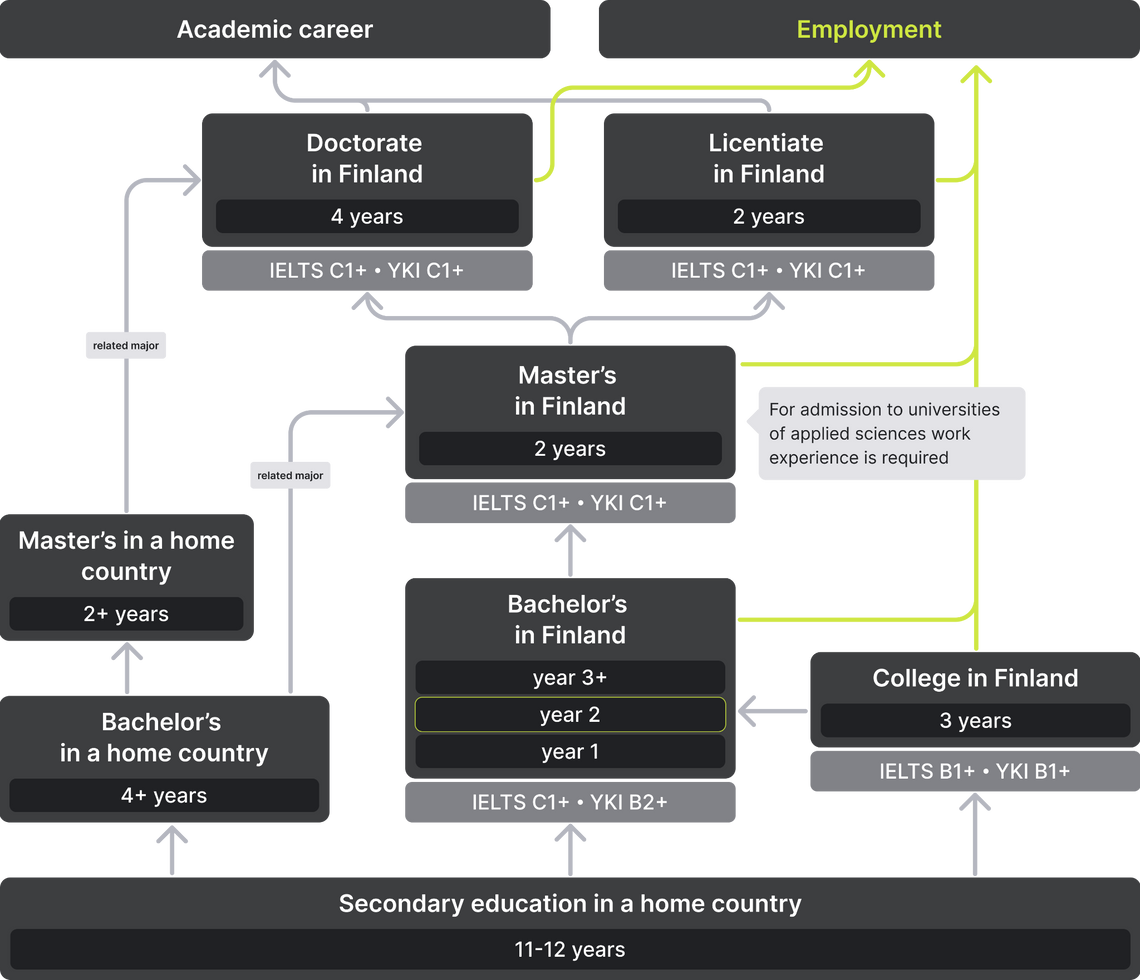
How to choose a university
The first step in choosing a university is determining your desired field of study and identifying your priorities for further education. We discuss this in a separate article.
When deciding on a university in Finland, you should consider several important criteria.
Institution type
Finland has two main types of higher education institutions:
- 13 universities — often referred to as universities of sciences, these institutions prioritize research-oriented programs.
- 22 UAS — universities of applied sciences focus on practical education, tailoring their programs to meet market demands.
Only traditional universities offer PhD programs. Additionally, they provide a wider range of programs, with 1212 courses compared to 541 available at applied universities[-].
While the admission process is similar for both types of institutions, entrance exams tend to have a more significant role at UAS.
Curriculum
When assessing programs, take a close look at the subjects included in their curriculums. You can find detailed information on university websites. Keep in mind that courses with identical names may vary significantly in content and entry requirements.
International rankings
University rankings come in two main categories: general and subject-specific. General rankings consider various indicators to determine the position of a university in the global academic landscape.
In the overall QS ranking, Finland boasts two universities in the top 150: Helsinki University and Aalto University[1].
However, for a more tailored approach to university selection, it is best to focus on subject-specific rankings. These rankings highlight where a particular field of study excels. At Finnish universities, areas like design, business and management, architecture, computer science, and pedagogy are notably strong.
- University of Helsinki ranks 6th in design and 28th in pedagogy
- University of Turku excels at nursing, ranking 28th, and is in the top 100 for pedagogy[2]
- The University of Eastern Finland is ranked 51st in nursing and is among the top 300 universities in fields such as ecology, pharmacy, and pharmacology[3]
- Aalto University stands out globally, securing the sixth position in the field of art and design
Budget
If you are seeking cost-effective study options, consider programs conducted in Finnish and Swedish. They are free for all, including international students.
Costs for English programs in English start at 10,000 USD per year. Consequently, securing a scholarship becomes essential to offset a portion of your educational expenses.
The most budget-friendly bachelor’s programs taught in English — priced under 5,000 USD — can be found at the University of the Arts Helsinki[4].
Programs in English
If your preference is to exclusively study in English, Finnish universities of applied sciences offer approximately 100 bachelor’s and 20 master’s programs.
Traditional universities offer a smaller selection, with only 10 bachelor’s and about 100 master's programs[5].
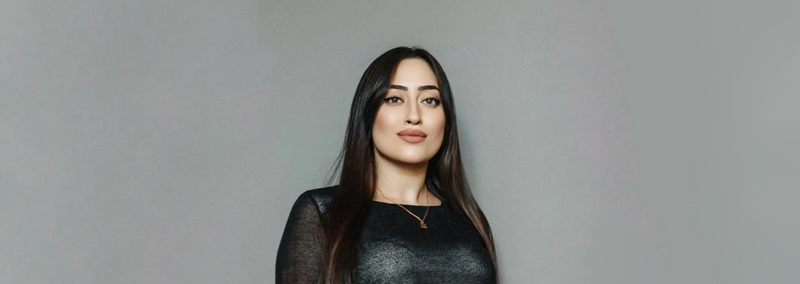
Best universities in Finland
Items 1-6 of 65
Advanced searchUniversity of Turku
Finland, TurkuAalto University
Finland, EspooUniversity of Oulu
Finland, OuluUniversity of Jyväskylä
University of Eastern Finland
Finland, Kuopio
Requirements for admission to Finland
In Finland, you can pursue higher education immediately after completing the 11th grade. Students have the option to study in English, Finnish, or Swedish.
You can apply to two types of universities: research universities and universities of applied sciences (UAS).
While both have the same document requirements, entrance exams hold greater significance at universities of applied sciences.
Documents for admission:
- High school diploma and grade transcript
- Language certificate at B2 level — IELTS, TOEFL, Cambridge ESOL's tests, Pearson Test of English (PTE), YKI for Finnish, and SWEDEX for Swedish
- Completed application
- Passport
For bachelor’s programs, students may also need to provide SAT exam results, a description of their school curriculum (course description), and occasionally a motivation letter and recommendation letters.
When applying to master's programs, students must provide an academic resume and recommendation letters. Universities of applied sciences may additionally require confirmation of work experience in the relevant field.
How to enroll at a Finnish university
- Find suitable programs on the StudyInfo.fi portal
- Review the admission requirements
- Successfully complete language exams and, if necessary, entrance tests
- Submit your documents through StudyInfo.fi
- Await the admission results
- If accepted, confirm your place of study by submitting your original documents to the chosen university
Diploma legalization and recognition
Finland is a participant in the Hague Convention, simplifying the legalization process for diplomas and certificates. To legalize your diploma, you only need to obtain an apostille. For educational documents originating from the EU or Nordic countries (Norway, Sweden, Denmark, Iceland), additional legalization is not required.
Documents must be translated by an authorized translator, whose information can be found on a designated website. The language of translation should align with the specific requirements of the program.
For further details regarding types of legalization, please visit the Digital and Population Data Services Agency website.
Read more about: legalization of educational documentsApplication deadlines in Finland
Finnish universities have two semesters — autumn (August / September to December) and spring (January to May).
For the autumn semester, document submission typically occurs from January to March. However, universities establish their own specific deadlines, which are often quite brief — ranging from two weeks to a month.
In Finland, there are a limited number of programs that begin in the spring semester. In such cases, applications must be submitted in early to mid-September[6].
For precise deadline information, please refer to the respective university websites.

Application submission
Documents to Finnish universities must be submitted through a designated website — Studyinfo.fi. Here, you can also explore suitable programs and access official university websites and contact information.
In Finland, there are three document submission methods: joint application, separate application, and rolling application.
Joint application. This entails completing a single registration form for multiple universities at once. You do not need to send documents to each university individually or keep track of various deadlines. The Ministry of Education and Culture establishes uniform admission deadlines. You can apply to a maximum of 6 universities through this method.
Most programs taught in English are available through the joint application method.
The joint application procedure occurs three times per year:
- In January, for English programs starting in the fall semester (August / September)
- In March, for Finnish and Swedish programs starting in the fall semester
- In August-September, for a smaller selection of programs offered in any language for the spring semester
You can find a list of programs that are available for joint applications here.
Separate application — applicants submit their documents to each university individually. Under this approach, you can apply for an unlimited number of programs. If you are applying for multiple programs at one university, you do not need to send separate documents for each one; simply list all your chosen programs in the application.
For most programs, separate applications can be submitted through Studyinfo.fi. However, certain universities and specific programs may require applicants to submit their applications through their own website.
You can view the list of programs that fall under the separate application process here.
Rolling admission. Allowing applicants to apply throughout the year, this is a convenient method for those who have not yet completed their secondary education or bachelor's degree.
You can find the list of programs with rolling admission here.
Preparatory programs — Foundation in Finland
Finnish universities do not offer specific preparation courses. If your goal is to study in Finnish, you have the option to begin preparations in advance and enroll in a Finnish high school. This way, you can gradually improve your language proficiency and acclimate to life in the country.
Following the ninth grade, students can enroll in specialized preparatory programs designed for foreign students, such as TUVA. This program includes the study of Finnish and English, mathematics, social sciences and computer skills[7]. Additionally, experienced advisors provide guidance on university admissions. Some educational institutions permit students to merge the preparatory year with their high school education by transferring earned credits.
To qualify for these programs, you should have a proficiency level of at least A2 in Finnish or Swedish and have completed nine years of high school.
| Organization | Location | Entrance exams |
|---|---|---|
| Kastelli Community Center | Oulu | Interview |
| Mäntsälä High School | Mäntsälä | Interview |
| Vuosaari High School | Vuosaari | Finnish language exam, interview |
| Karku Evangelical College | Karku | Interview |
| Staircase Christian College | Lapinlahti | Language certificate |
How to apply for a bachelor's program
Most bachelor’s programs offered by Finnish universities can be found here.
You can enroll in a bachelor's program at a Finnish university immediately after the 11th grade. The duration of these programs is typically three years at traditional universities and from 3.5 to 4.5 years at universities of applied sciences.
There are three methods for submitting your application:
- Joint admission — occurs three times a year and allows you to apply to a maximum of 6 universities using a single application form
- Separate admission — requires you to apply to each university individually, with an unlimited number of applications
- Rolling admission — accepts documents throughout the year
Required documents
- Completed application
- Passport copy
- High school diploma and grade transcript
- or a grade transcript for the last 3 years of study if you have not yet finished school
- For programs in Finnish — YKI exam results, and for programs in Swedish — SWEDEX results
- For programs in English — IELTS 6.0, TOEFL 79, Cambridge ESOL's tests 170, or PTE 51
- Recommendation letters
- Motivation letter
- CV
Additional requirements:
- Entrance exams, which test knowledge of Finnish or Swedish, are necessary for nursing and medical programs
- Interview
- SAT exam results
- Course description
Some universities, such as Arcada University, accept electronic certificates of language exams and the SAT exam from relevant organizations. In such cases, during registration, you should request that the exam results be sent directly to the university.
Specific requirements for language proficiency and documents may vary depending on the university and the program. Check for exact information on the official website of your chosen institution.
Bachelor’s application deadlines
Applications are typically accepted from January to March, with the academic year starting in September. Specific application deadlines are determined by individual universities. These deadlines are often quite short, ranging from just two weeks to one month.
After being accepted to a university, you will be required to present your original documents for final verification. The deadline for this verification process is usually in early September.
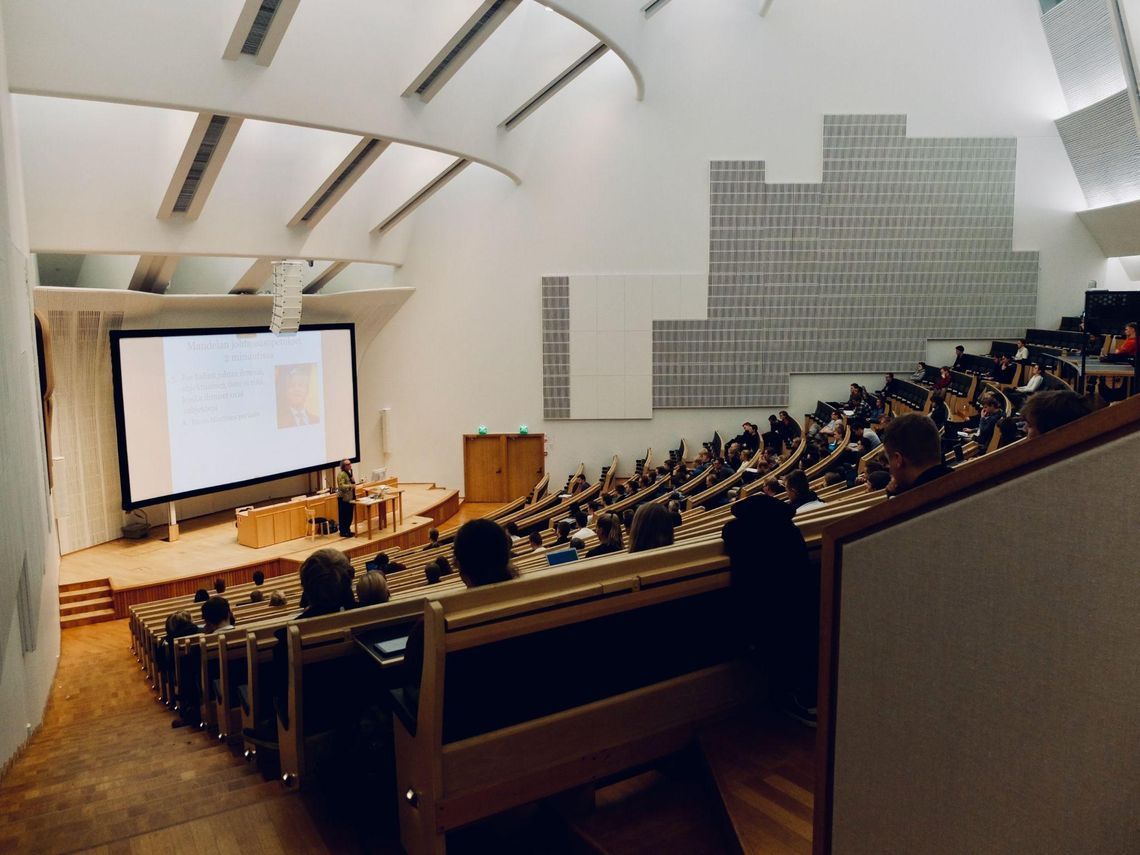

How to apply for a master’s program
You can explore available master's programs here.
In Finland, you can apply for a master's program in the same or related field as your bachelor's degree.
Master's programs at universities of applied sciences typically last 1.5 years, and they require a minimum of 2 years of work experience for admission. For creative fields, a portfolio showcasing your work experience and achievements, such as competition wins, participation in festivals, exhibitions, and more, may also be accepted as part of your application.
At traditional universities, master's programs last 2 years, and prior work experience is not a mandatory requirement.
For some specializations, particularly in fields like medicine, students follow a combined bachelor’s and master’s program, which lasts 5-6 years.
The process for submitting documents to master's programs is similar to that of bachelor's programs, including joint, separate, and rolling admission methods.
Required documents
- Completed application
- Passport copy
- Bachelor’s degree with grade transcript
- or a grade transcript if you have not yet finished your bachelor’s studies
- For programs in Finnish — YKI exam results, and for programs in Swedish — SWEDEX results
- For programs in English — IELTS 6.0, TOEFL 79, Cambridge ESOL's tests 170, or PTE 51
- Proof of work experience
- Recommendation letters
- Motivation letter
- CV
Master's application deadlines
Deadlines for applications vary among universities. However, as a general guideline, applications for the autumn semester are accepted from December through the end of January. Universities of applied sciences may extend their admission deadlines until March.
For the spring semester, which starts in January, applications are accepted in July and August.
MBA and EMBA programs in Finland
In Finland, you have the opportunity to pursue a master's degree in business administration (MBA). This field is relatively less popular in the country, with MBA and EMBA programs offered by only 5 universities.
MBA programs are designed for individuals aspiring to build a career in business and management, while EMBA programs are geared toward experienced top-level managers and business owners with 5-7 years of professional experience.
Required documents:
- Bachelor's degree in business-related field and grade transcript
- IELTS 6.5 or TOEFL 80
- Motivation letter
- 1-2 recommendation letters from teachers, colleagues, and employers
- CV
- 2+ years of work experience / 5+ years for EMBA programs
- Passport copy
- Passport photos
Please note that some universities may require GMAT or GRE scores and also conduct entrance examinations.
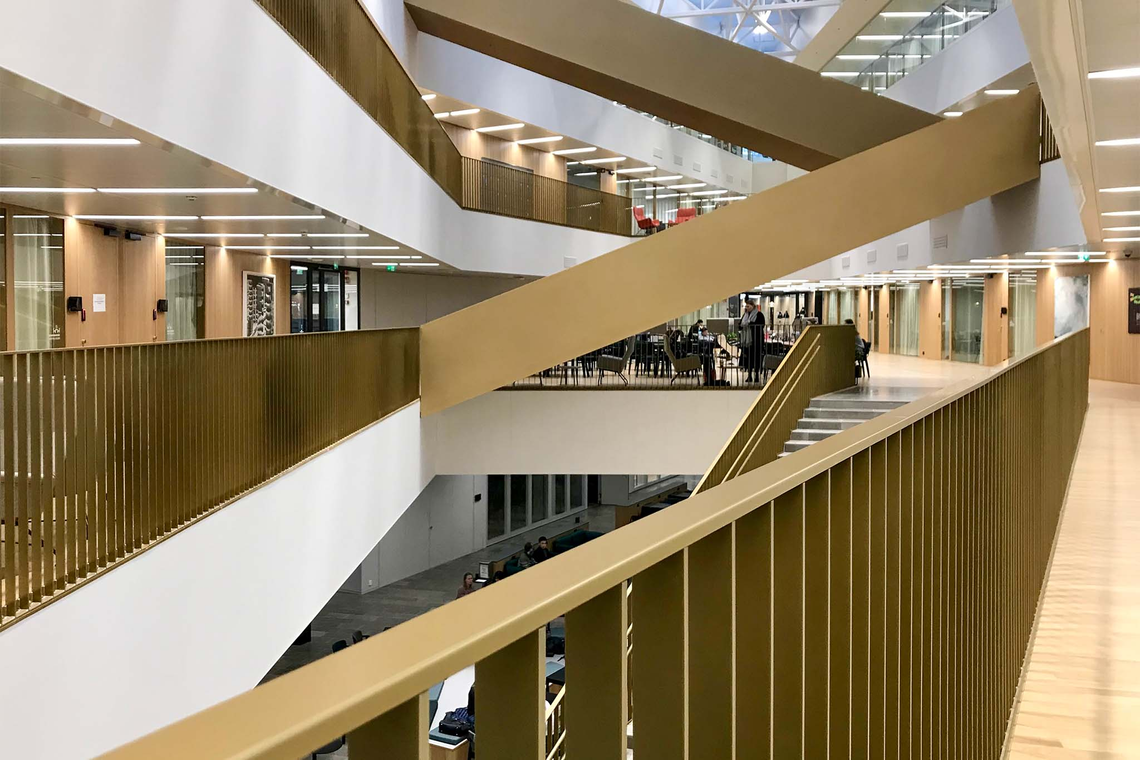
How to apply for a PhD program
Find the appropriate PhD program here.
In Finland, there are two pathways to continue your education after receiving a master's degree:
- Pursue PhD studies and earn a degree, typically in 4 years
- Enroll in a licentiate program and earn a licentiate degree, which takes 2 years
PhD programs are only available at traditional universities, and a crucial requirement is that your chosen field must align with or be closely related to your master's degree.
To be eligible for PhD studies, you should have a master's thesis grade of at least 4 out of 5 and an average GPA of 3.5 out of 5.
Additionally, you need to provide your master's diploma, a research plan for your future studies, and find a prospective supervisor.
You may also be asked to provide a supervision plan, which outlines the principles of your interaction with your supervisor: including work summaries, rights, obligations, and the number of meetings. This plan can be modified and expanded as needed, and you can find a sample on the website of your university.
PhD programs typically last for 4 years, with graduates earning 240 ECTS credits.
A licentiate degree is an intermediary qualification between a master's and a PhD. If you are not inclined to dedicate 4 years to a PhD or do not plan an academic career, a licentiate degree may be more suitable.
Admission requirements for licentiate programs are the same as those for PhD programs. Licentiate education has a stronger practical focus and is suitable for individuals who require research skills for employment in a company or their own business.
Licentiate programs last for 2 years, encompassing 60 ECTS credits.
After successful defense of your dissertation, which is smaller in volume compared to a PhD thesis, you are awarded a Licentiate of Science degree.
Required documents
- Completed application
- Passport copy
- Master’s degree with grade transcript
- For programs in Finnish — YKI exam results, and for programs in Swedish — SWEDEX results
- For programs in English — IELTS 6.5, TOEFL 92, PTE 62, Cambridge C1 Advanced or C2 Proficiency
- 2+ years of work experience
- Scientific publications
- Plan for future research
- Copies of your master's thesis, if applicable
- Information about your prospective supervisor
- Supervision plan
- Preliminary study plan, describing the curriculum of your previous level of education
- Recommendation letters
- Motivation letter
- CV
All documents must be submitted directly to the university and translated into Finnish, Swedish, or English while being notarized.
PhD application deadlines
Application deadlines vary between universities and specific programs. For example, at Aalto University, you have the opportunity to submit your documents once a month on specific dates. However, for certain engineering programs, applications may be accepted only twice a year. The University of Helsinki offers more flexibility, allowing applications to be submitted up to five times a year. To ensure you meet the deadlines for your chosen university and program, check and verify the specific dates well in advance.
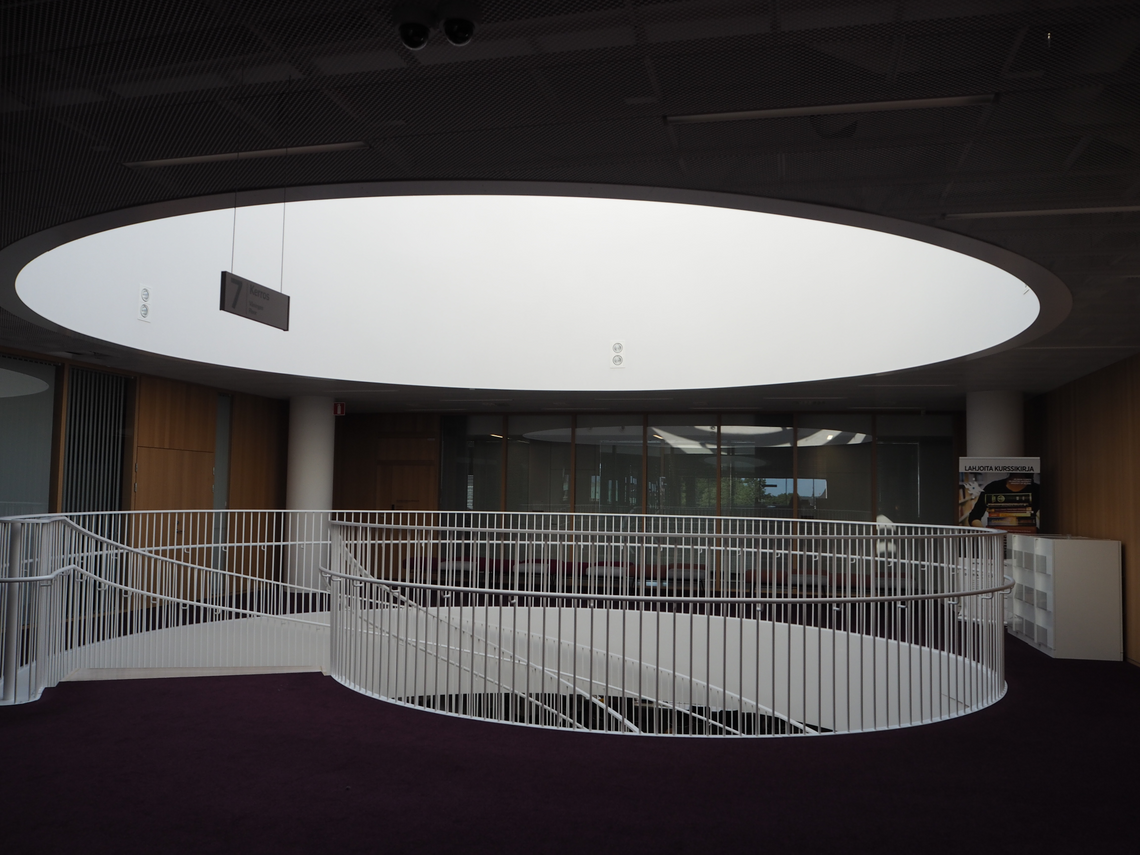
Scholarships in Finland
State scholarships are available to master's and doctoral students, while funding opportunities for bachelor's students come from universities and private organizations.
- Scholarships for bachelor’s and master’s programs are typically awarded based on merit and academic excellence.
- PhD students receive grants based on the significance and intermediate outcomes of their research.
Some private organizations offer financial assistance under specific conditions. For instance, companies like CustomEssayMeister provide scholarships for orphans, while universities like Nexford offer scholarships for women pursuing careers in business.


Finnish student visa
Foreign students intending to study in Finland must apply for a student visa, with a processing time of 2-3 months. The visa fee is 482 USD, but applying electronically can reduce the cost to 375 USD and expedite processing[8].
Required documents:
- International passport — it should remain valid for at least 3 months beyond the visa expiration date and have a minimum of 2 blank pages
- Completed visa application form with a photograph
- National passport homepage and registration copy
- University invitation confirming your enrollment
- Proof of financial solvency, such as a bank statement (showing a minimum of 7,204 USD per year or 600 USD per month) or a scholarship award letter[9]
- Medical insurance with coverage of at least 42,879 USD[10]
- Birth certificate for minor applicants
As of April 2022, a new law allows foreign students to receive a visa and residence permit for the entire duration of their study, eliminating the need for renewals[11]. This permit also lets students work up to 30 hours a week and provides an opportunity to obtain a work permit for two years after graduation.
Want to study at a foreign university but don't know where to start? We can help!
Our specialists will find a university, arrange your documents, fill out the applications, and stay in touch until you receive an offer.






